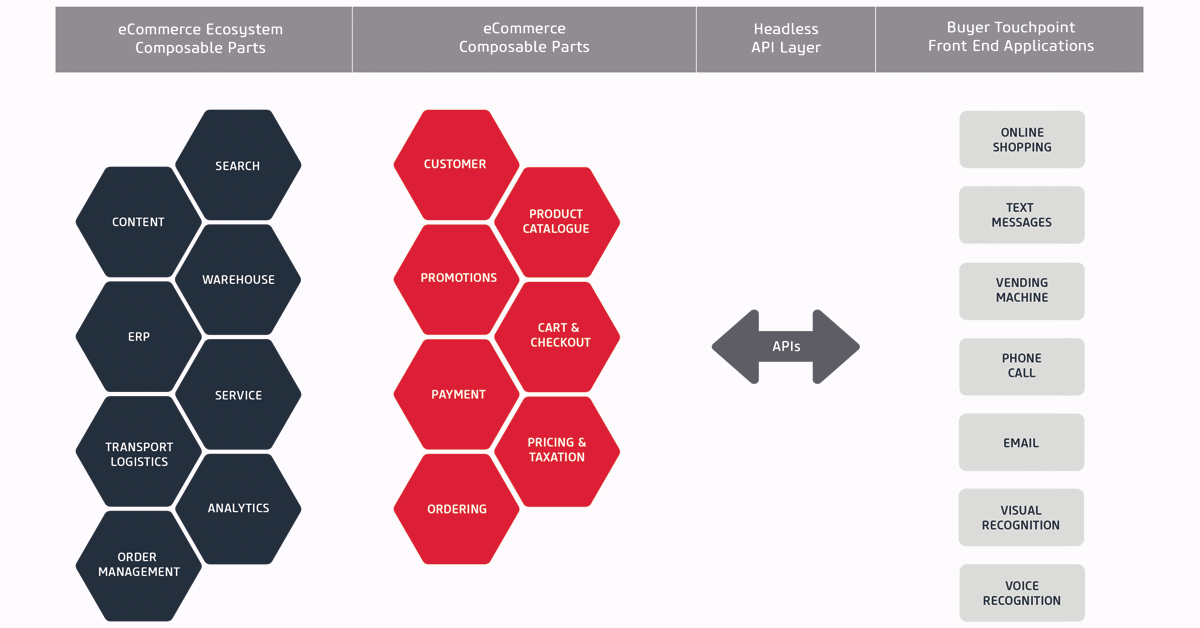Let's talk about headless and composable architecture business value to the B2B industry, including wholesale distribution. These two technical concepts are getting a fair bit of time and attention in the market today.

When they are correctly adopted, they allow an organization to evolve their B2B eCommerce offering as their market dictates. So, without diving too deep into the technical underpinnings, let's define the concepts:
- Composability is a system design principle that deals with the inter-relationships of components. A highly composable system provides parts that can be selected and assembled in various combinations to satisfy specific user requirements. Each composable component adheres to the high cohesion and loosely coupled design principles.
- Headless commerce is an e-commerce architecture where the front-end is decoupled from the back-end commerce functionality and can thus be updated or edited without interfering with the front-end, like a headless content management system.
The hexagons represent back-office composable components in the diagram below, each with a defined interface (API) to other components. There are two sets of back-office components, the core eCommerce and the related eCommerce ecosystem components. Also, in support of the buyer's purchasing journey, each rectangle represents a front-end component for a specific touchpoint type.
The Why?
The B2B market is in a high degree of flux, and your B2B strategy is likely evolving around growing your market. Composable commerce, which is really about providing long term flexibility, can directly support your strategy and deliver some very achievable benefits:
- Add new buyer touchpoints more easily: A customer's buying journey can include multiple touchpoints and devices, for example: social, 3rd party marketplace, voice, text, kiosks, vending machines, call center, connected devices (IoT), and mobile apps.
Using a composable and headless approach, new digital touchpoint implementations can be done quickly, with maximum flexibility and control over the customer experience (CX).
Like in B2C, B2B buyers are asking to have a seamless, efficient, personalized buying experience across each touchpoint. To accomplish this, a digital experience engine (DXP) can be included as a new component.
- Increased speed of innovation: Composable commerce allows you to adapt quickly to new B2B business models such as joining a marketplace, hosting a marketplace or including B2C. It also includes the ability to integrate new value-added digital services more efficiently.
As typical eCommerce capabilities become commodities, wholesale distributors can continuously look for opportunities to differentiate by taking advantage of emerging technologies.
- Future-proof your architecture: Nothing is entirely future-proof, but a loosely coupled, high-cohesion architecture allows you to replace one poorly performing eCommerce component without re-platforming your entire eCommerce solution.
Challenges
The following is a list of topics when considering this approach:
- While the core characteristics of composable architecture have been understood for some time, the overall support infrastructure is still maturing; for example, you often must manage multiple vendors and the timing of their upgrade paths. This is a new level of communication and coordination that can often be overlooked.
- Your business's projected size must warrant the implementation of a composable architecture, including adopting additional touchpoints, stores, and channels.
- The IT organization should understand the principles of composable architectures and also have the capabilities to develop and support them.
- The B2B industry, particularly wholesale distribution, is disrupted by adjacent business models and emerging digital technologies. As a result, B2B eCommerce service offerings must be nimble to remain competitive.
Need help defining your eCommerce digital transformation strategy, including understanding how a composable architecture relates to you, or need help deciding where to start?
Online Business Systems can work with you on an eCommerce strategy and roadmap that includes defining the need and approach to your company's adoption of a composable and headless eCommerce architecture.
About Gil Meier, Senior Consultant, Digital Transformation
 Gil Meier is passionate about ever-changing digital technology and its opportunities in various industries, particularly B2B.
Gil Meier is passionate about ever-changing digital technology and its opportunities in various industries, particularly B2B.
Gil helps companies define and deliver their digital transformation growth by applying innovative products, services, and business models that take advantage of digital technologies.
Check out more great blogs from Gil:






Submit a Comment